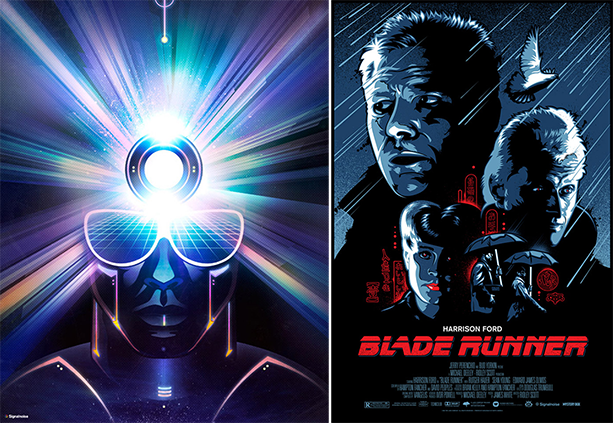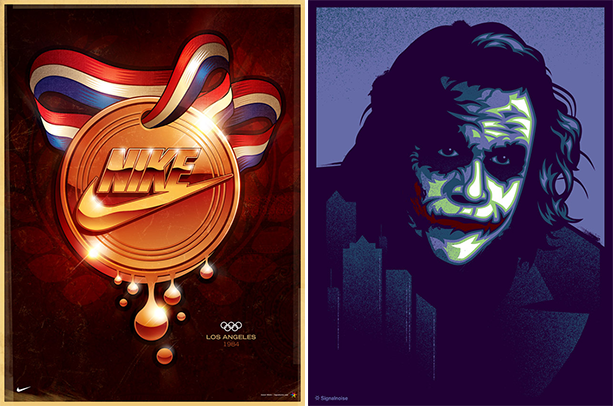I recently interviewed James White of Signalnoise, a design studio in Nova Scotia. James is set to take the stage at Design Renegade on Thursday, November 15.
The presentation you’ll be giving at Union/Pine on November 15 is called Design Renegade. How did that theme emerge and why do you feel this message is important?
The bulk of the work I’ve developed for Signalnoise is personal projects. Five years ago while working at an agency by day, I’d work on my own stuff until the wee hours of the morning. I would invent projects for myself to work on, like a personal art series, children’s book, character design, movie posters…basically whatever I thought would be fun to do. There was no greater goal and no client. I was essentially a renegade in my own right, doing art and design behind closed doors then posting it on my website. After a while, these passion projects caught the eye of big clients and I was able to leave my agency job to pursue the fun stuff full time.
The theme of Design Renegade is just that, how the personal projects bring forth a passion for the medium and ultimately cultivate interest from paying clients. I played against the rules and it ended up building my future… even though I was just doing it for fun at the time.
Some might describe your illustration as retro in both style and subject matter. How has your work evolved over this past year and why?
It’s interesting. When I started developing my personal body of work 5 years ago I was consciously recreating themes and styles from the 70s and 80s. Just saturating my work the flares, lasers, rainbows, chrome text and a zillion colours. Really wearing that influence on my sleeve. As time passed I got a little bored with all the Photoshop trickery and moved toward building my stuff in Illustrator. 100% vector with only 5 or 6 colours. I needed a new challenge and that was definitely it.
I still hear the word “retro” being used to describe my work, which is totally cool. However the vector work I’m doing isn’t as blatantly 80s influenced as my older stuff. Or maybe the ideology of childhood influence is below the surface now in terms of style. BUT, the content is certainly still old school. I love designing for movies like Blade Runner and Masters of the Universe and Indiana Jones. So in the light of content, I haven’t strayed too far from the “retro” path.

You’ve described yourself as a “horribly nostalgic guy” constantly pulling inspiration from the past. In your opinion, how does one’s childhood play into being a modern day designer?
Well, I can only speak from personal experience, so here we go. I was drawing since age 4 and never stopped all the way through junior high and high school. Once I graduated I was accepted into Graphic Design at a local community college, then a course called Interactive Tech (learned Flash and website design basically) and was scooped up into the web industry right away. BUT, all the while I never stopped drawing and using what I learned in school to build my own projects. You know, the stuff I wanted to work on all my life now that I had the tools to do it.
When people enroll in graphic design it’s normally because they draw, or paint or whatever. And they do that stuff because they love to do it. Then in school they are hammered with the “you need to find gainful employment” thing, so their attention switches from the fun stuff to the work stuff. They forget why they wanted to chase design in the first place.
So…from my perspective, my childhood plays a HUGE roll in my career because I never lost that dumb passion. I never switched to only pleasing the employer. I believe a modern day designer HAS to remember who they were when they were young and dumb. Back then we did stuff out of love, not obligation. And that’s a big deal, y’know?
When and why did you decide to strike out on your own? As a result, how has your workflow changed?
I only went freelance about 2 years ago. Before that I was stupidly working two jobs…agency by day and my clients by night. It was kind of horrible jamming all that work in with little to no time for anything else. I decided I had enough work on my own to strike out, and I did so out of necessity, otherwise I’d go nuts.
The workflow changed for me in a big way. See, for 10 years prior I was used to having someone tell me what to do. My schedule was already laid out so all I had to do was the work. When I went freelance I had nobody there but myself so it was a little freaky, I won’t lie. It took me months before I felt kind of secure enough to do my work and function on my own. I still suck at some stuff—like emailing; I’m the worst—but I’ve learned quite a lot about process and a lot about how I work as a designer. Going freelance really grew me up, for lack of a better way of putting it.
As a visual designer you’ve worked with several creative publications. Which of them provided the most interesting project?
Even though I don’t do them often, one of the most interesting was working with Advanced Photoshop magazine on a tutorial. Essentially I had to develop a piece and break it down into 16 easy steps for anyone to follow. I was an absolute wreck for the first while because my process at that point had become a blur of subconscious, impulsive and gestural steps. I’ve been doing this stuff for so long that my process was super organic. Now I had to stop and think about what I was doing, how I was doing it, AND write it so someone else could follow. Yikes.
The reason I say that was the most interesting is because it forced me to watch my own process. All the little steps in there that I never thought about. I could then manipulate them, simplify them and ultimately teach them to someone else. Passing on your knowledge is a big deal, and writing those tutorials certainly helped me with that.

Based on your experience, what are the pros and cons of being successful in our field?
First off, “success” is a term that is definitely relative. I can’t speak for other designers out there, but I’ve never felt any kind of a plateau that I reached which made things easier, simpler and worth more money. Never happened. I’ve always felt like my career is an uphill battle but that’s exactly where I want to be. I need to keep pushing myself to evolve and explore new things. To me, “success” sounds like complacency and I never want to be complacent. That’s super boring.
Pros and cons are easy. Pros, the longer you do this stuff the more opportunities you get to do cool stuff. More people see your work and they want you to do that for them, which is awesome. I’ve met some amazing people in this industry, both colleagues and clients. Another HUGE pro is being given the opportunity to travel and meet other designers and artists. That’s the best feeling in the world, to shake someone’s hand and hear their story. Everyone is on a different path.
The only con I can think of is time. Just because you get more opportunities doesn’t mean you get more hours in the day. Keeping up on stuff is a challenge for sure. But, I wouldn’t trade this industry for the world.
Analog vs. digital, which is cooler?
Tough one because I dance on the line between them. I draw all the time, and I start each project in the sketchbook. But the end game of everything I do is on the computer. I’m a definite mix of both.
But if we’re talking strictly “cool” factor…if you’re at a pub sitting at the bar and drawing something rad, you are DEFINITELY the coolest guy in the place. The staff and other patrons will go out of their way to check out what you’re doing and say “Wow, that’s cool!”. Might even land you a free beer or two. Ha!
See you next Thursday.